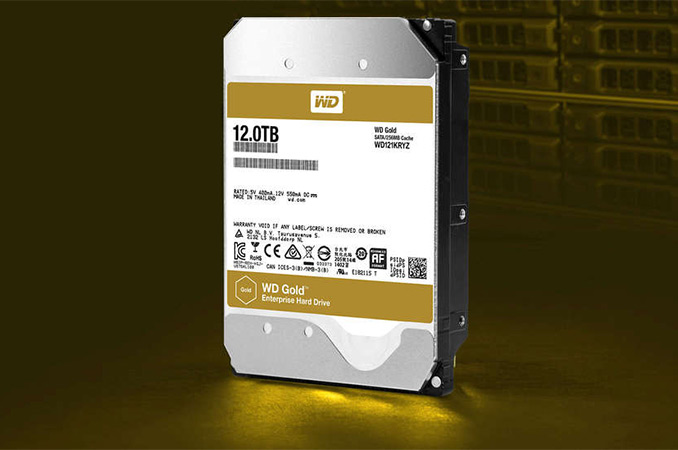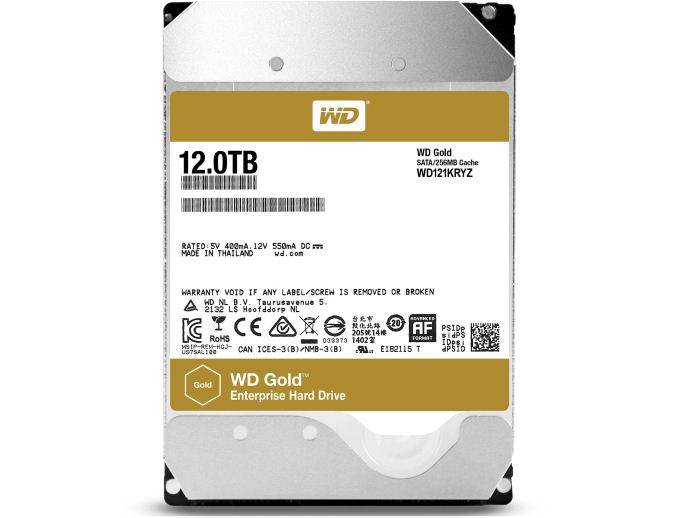Western Digital Ships 12 TB WD Gold HDD: 8 Platters and Helium
by Anton Shilov on September 16, 2017 9:00 AM EST- Posted in
- HDDs
- Storage
- WD
- Western Digital
- Helium HDD
- WD Gold

Western Digital has begun to ship its WD Gold HDD with 12 TB capacity to partners and large retailers. The 3.5” drive relies on the same platform as the HGST Ultrastar He12 launched this year, and will initially be available to select customers of the company. The WD Gold 12 TB is designed for enterprise workloads and has all the performance and reliability enhancements that we come to expect, but the availability at retail should make them accessible to wider audiences.
From a hardware point of view, the WD Gold 12 TB is similar to the HGST Ultrastar He12 12 TB hard drive: both are based on the fourth-generation HelioSeal technology that uses eight perpendicular magnetic recording platters with a 1.5 TB capacity for each platter. The internal architecture of both HDDs was redesigned compared to predecessors to accommodate the eighth platter. Since the WD Gold and the Ultrastar He12 are aimed at nearline enterprise environments, they are equipped with various sensors and technologies to protect themselves against vibration and as a result, guarantee sustained performance. For example, the WD Gold and the Ultrastar He12 attach their spindles both to the top and the bottom of the drives. In addition the HDDs feature a special technology that increases the accuracy of head positioning in high-vibration environments to improve performance, integrity, and reliability. Finally, both product families support TLER (time-limited error recovery) rebuild assist mode to speed up RAID recovery time.
Since the WD Gold 12 TB and the HGST Ultrastar He12 are similar internally and feature the same 7200 RPM spindle speed, they also have similar performance — the manufacturer puts them both at 255 MB/s sustained transfer rate and 4.16 ms average latency. The main difference between the WD Gold and the HGST Ultrastar He12 are the enterprise options for the latter: there are models with the SAS 12 Gb/s interface and there are models with SED support and Instant Secure Erase feature.
| Comparison of Western Digital's WD Gold HDDs | ||||||||
| WD121KRYZ | WD101KRYZ | WD8002FRYZ | WD6002FRYZ | WD4002FRYZ | ||||
| Capacity | 12 TB | 10 TB | 8 TB | 6 TB | 4 TB | |||
| RPM | 7200 RPM | |||||||
| Interface | SATA 6 Gbps | |||||||
| DRAM Cache | 256 MB | 128 MB | ||||||
| NAND Cache | Unknown | No | Yes | Unknown | ||||
| Helium-Filling | Yes | No | ||||||
| Data Transfer Rate (host to/from drive) | 255 MB/s | 249 MB/s | 205 MB/s | 226 MB/s | 201 MB/s | |||
| MTBF | 2.5 million | |||||||
| Rated Annual Workload | 550 TB | |||||||
| Acoustics (Seek) | - | 36 dBA | ||||||
| Power Consumption | Sequential read | 7 W | 7.1 W | 7.2 W | 9.3 W | 9 W | ||
| Sequential write | 6.8 W | 6.7 W | 7 W | 8.9 W | 8.7 W | |||
| Random read/write | 6.9 W | 6.8 W | 7.4 W | 9.1 W | 8.8 W | |||
| Idle | 5 W | 5.1 W | 7.1 W | 7 W | ||||
| Warranty | 5 Years | |||||||
| Price as of September 9, 2017 | MSRP | $521.99 | $410.99 | $327.99 | $244.99 | $183.99 | ||
| Per GB | $0.0435 | $0.0411 | $0.041 | $0.0408 | $0.046 | |||
| GB per $ | 22.98 GB | 24.33 GB | 24.39 GB | 24.48 GB | 21.73 GB | |||
Western Digital aims its WD Gold and HGST Ultrastar He-series drives at operators of cloud and exascale data centers that demand maximum capacity. The 12 TB HDDs can increase the total storage capacity for a single rack from 2440 TB to 2880 TB, replacing 10 TB drives with 12 TB drives, which can be a major benefit for companies that need to maximize their storage capacity per watt and per square meter. Where the HGST-branded drives are made available primarily through B2B channels, the WD Gold are sold both through B2B and B2C channels and thus can be purchased by wider audiences. For example, boutique PC makers, as well as DIY enthusiasts, may start using the WD Gold 12 TB for their high-end builds, something they could not do with the HGST drives. These HDDs may be considered as an overkill for desktops, but since WD’s desktop offerings top at 6 TB, the WD Gold (and the perhaps inevitable future WD Red Pro 12 TB) is the WD’s closest rival for Seagate’s BarraCuda Pro drives.
The WD Gold HDD is currently available directly from Western Digital for $521.99 as well as from multiple retailers, including Newegg for $539.99. While over $500 for a hard drive is expensive, it is actually less than Western Digital charged for its WD Gold 8 TB about 1.5 years ago ($595) and considerably less than the initial price of the WD Gold 10 TB drive last April.
Related Reading:
- Western Digital: Sales of Helium-Filled HDDs Accelerating, 15M Sold So Far
- Western Digital Starts Shipments of HGST Ultrastar He12 12 TB HDDs
- Western Digital Expands Purple Lineup with a 10 TB Helium-Filled HDD
- Western Digital Announces Ultrastar He12 12 TB and 14 TB HDDs
- Western Digital Adds Helium-Filled WD Gold 10 TB HDD to Lineup
Source: Western Digital











62 Comments
View All Comments
Samus - Sunday, September 17, 2017 - link
Wow. This statement is plain fucking stupid. Saying anything may never arrive in the consumer space, short of a time machine and a nuclear bomb, lacks all imagination. 50 years ago, people like you said 'computers' would never become consumer devices.As soon as HAMR is ironed out, will have 20TB+ consumer drives, probably in a few years.
Armus19 - Sunday, September 17, 2017 - link
I think he is just a bit out of touch but that he has a point. SSD's may simply kill off old style harddrives. Also, who needs massive storage at home these days? For nearly everyone existing drives are more than enough now that ppl stream movies rather than download.Yes ofc datacenters have use for more capacity, but they may be able to adopt SSD type technologies quicker than home users.
I think the picture isn't as clear as it might seem. And since HDD manufacturers aren't really pushing it to release higher capacity, I think, so do they.
Hurr Durr - Sunday, September 17, 2017 - link
Well, if you want to actually own your content, you will need storage.egmccann - Monday, September 18, 2017 - link
depends on your needs. If all you want to do is surf the web and stream media? Sure. No reason for anything more than a smallish (<1 Tb) SSD. Some of us do other things with our computers, though - and like to have those things available to us even if there are internet issues.jabber - Friday, September 22, 2017 - link
Yeah I'm one of those that feels more than 1TB of data is a major liability and millstone round my neck. I hate having 'precious' data. So I don't hoard movies or music. I also try to take as few pics as possible. I never look at them hardly so what's the point? Personal data is a liability and whether you own it or not can be so fleeting and vulnerable to obsolescence.DanNeely - Sunday, September 17, 2017 - link
Dunno about that. HAMR should lift capacities a lot; but I've read it's expected to be expensive. If that's the case I wouldn't be surprised it if doesn't trickle down below high end prosumer drives (eg WD Red Pro) for a long time after general availability if ever. Mid 2020's projections for flash surpassing spinning rust as the cheapest way to get a terabyte of storage suggest that many still in R&D HDD techs will either never see the light of day or get trapped in premium market segments indefinitely.Samus - Monday, September 18, 2017 - link
In 2009, almost a decade ago, when the Intel X25-M 160GB went mainstream, then the SSD320 with 600GB capacity a year later, people proclaimed NAND would be in the gigabytes for a fraction the cost in short time. 7 years later, prices have only marginally dropped when contrasting with spinning glass.Listen, I think 40 year old hard disk technology (winchester technology) needs to die at some point. It is just amazing we still rely on technology pioneered in the 70's for practically all mass storage. But at the same time, NAND is not the short term solution. It wasn't 10 years ago, and it won't be 10 years from now. There is no way in the next decade NAND will be price competitive with magnetic/optical storage. The trends and prospects of each competing technology affirm my observation.
Sure, HAMR will be expensive, but it will explode density, probably doubling capacity of enterprise drives and making consumer drives (and yes, there will be consumer HAMR just like there is now consumer Helioseal) large and affordable at the expense of some performance and warranty length.
Yes, the world is going mobile, the world depends on less local storage, and the world is streaming, but content is larger than ever, and will continue to expand. In a decade, who knows, we might need 12TB drives just to store a few movies. We need to keep pushing the envelope on all fronts. It just pisses me off when someone says something wont hit the consumer space. The consumers are the final frontier for any marketable product, be it a hard disk, autonomous vehicle, or space pod to travel to another planet.
hlm - Monday, September 18, 2017 - link
I hope HAMR can succeed, but I am wondering if MAMR will be the way to go with HAMR struggling with heat issues.Samus - Monday, September 18, 2017 - link
One way or another, we will always have larger drives for less as time goes on. How we get there is really irrelevant as long as it isn't through some ghetto side-stepping like SMR. I'm not one to trust Seagate on new technologies, either. Hitachi developing Helioseal is one thing, that was Hitachi. Seagate developing something unarguably much more complex like HAMR leaves a lot to be desired when considering reliability. I just don't think Seagate is up to the task. They're the Chrysler of hard drive manufactures.saratoga4 - Saturday, September 16, 2017 - link
Seagate was saying they'd do 16GB HAMR drives, probably in 2018. Of course HAMR is forever delayed, so that date might slip.